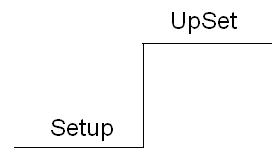Setup Upset
Anyone can get upset from time to time, but it may not be for the reason they think. Many years ago, Steve Andreas introduced me to an idea from John McWhirter, an NLP practitioner in Glasgow, Scotland. John's idea was that every "upset" begins with a "setup". And we tend to be even more upset because we participated in the "setup" for the upset.

Think about it this way: Have you ever gotten behind a slow driver and cursed your luck or the other driver? (Upset) If you rewind your experience a little, you may find that you had an intuition to get in another lane before you got stuck behind the slow driver. (Setup) In that moment, you are probably more upset with yourself for ignoring your intuition than you are with the other driver.
Have you ever taken a job only to find that you hate your boss or the work? (Upset) If you rewind your experience a little, you may find that you took the job because you were tired of looking or needed the money. (Setup) Again, you may be more upset with yourself for getting lazy or needy than with your boss or the work.
All too often, I have found, I'm upset with myself for participating in the setup; I'm not so upset with the external world that colluded with me to create the "upset".
Golf professionals say that the most common problem amateur golfers face is improper setup. Alignment of the body to the golf ball and target, grip and so on are critical to proper contact with the ball. Bad setup = bad result. A good setup, on the other hand, ensures a better result. How do you ensure a better setup? Tape editing.
Tape Editing
Once you understand this setup-upset sequence of events, it's easy to go back and change the way it would have turned out and how it will turn out in the future.
Tape editing is just what it sounds like:1) rewind your experience to point where you made the decision that led to the upset (to not change lanes or to take the wrong job); 2) think of two or three ways to have made a better choice (e.g., change lanes, change the route, ask more questions before you take the job); 3)rerun the experience using different choices until you find several that would have avoided the "upset" completely, yielding a neutral or successful result:

By taking a few minutes to identify better decisions and try them out, you build flexibility about future situations. Your upsets will be fewer and you'll have a strategy for the ones you do have.
E + R = O
Jack Canfield has a similar model that he calls E + R = O: Events + Response = Outcome. Again, it's your Response to the Event (setup) that yields the Outcome (upset or success). Jack says: Change your response to the event and you'll change the outcome.
Here's My Point
Upsets happen, but we don't have to be a puppet to our emotions. Using tape editing, we can build in choices and better decisions so that the future will be free of similar upsets and full of greater success. Isn't it time to perfect your setup?

